Scoliosis is a postural deviation indicated by a lateral curvature of the spine greater than 10 degrees. There are two primary categories for scoliosis: nonstructural and structural. Non-structural is related to posture, while structural is related to deviations within the bone itself. Structural forms of scoliosis are not correctable; however, non-structural forms can be significantly improved with proper exercise programming. The most common non-structural form of scoliosis is idiopathic scoliosis, which has no specific identifiable cause but is diagnosed by the degree, balance and rotational characteristic of the curvature in the spine. Depending on the severity of the curve, most individuals with idiopathic scoliosis will be asymptomatic and pain free, yet may exhibit some performance deficiencies
When working with clients who exhibit a lateral curvature in the spine, it is important to interpret the functional limitations and muscular imbalances associated with the condition to successfully implement exercises for scoliosis aimed at improving strength, range of motion and the length-tension relationship of the working musculature on both sides of the vertebral column.
Range of Motion
Range of motion is defined as the capacity and potential of a joint to freely and painlessly move throughout its defined plane(s) of motion. Because of the lateral curve of the spine in idiopathic scoliosis, a C or S shape exists, which consists of a convex and concave asymmetry of the spine and results in shortened (tight) musculature on the concave working muscles of the spine and lengthened (latent) muscles on the convex portion of the spine. These imbalances can significantly reduce the unilateral range of motion at the trunk and articulating joints, which leads to a loss of functional performance and creates postural asymmetries.
Self-myofascial Release
Connective fascia is one of the most significant contributors to lengthening resistance in a relaxed muscle and overall range of motion at a joint. Because of the compromised integrity of the spine specific to scoliosis, the myofascial alignment can be altered, resulting in dysfunction. Therefore, instructing a client with idiopathic scoliosis through a self-myofascial release protocol can allow for the loosening of the fascial connective tissue so that improved posture and range of motion can be achieved. The myofascial release protocol should focus on the concave side of the spine where the shortened musculature exists.
Thoracic Scoliosis
Thoracic scoliosis refers to a lateral deformity in the middle (thoracic) portion of the spine and is the most common location for spinal curvature. Thoracic scoliosis is generally associated with a deformity of the rib cage as well as the spine itself, which can have implications on shoulder elevation, transverse trunk mobility and, in severe cases, breathing.
Lattisimus dorsi
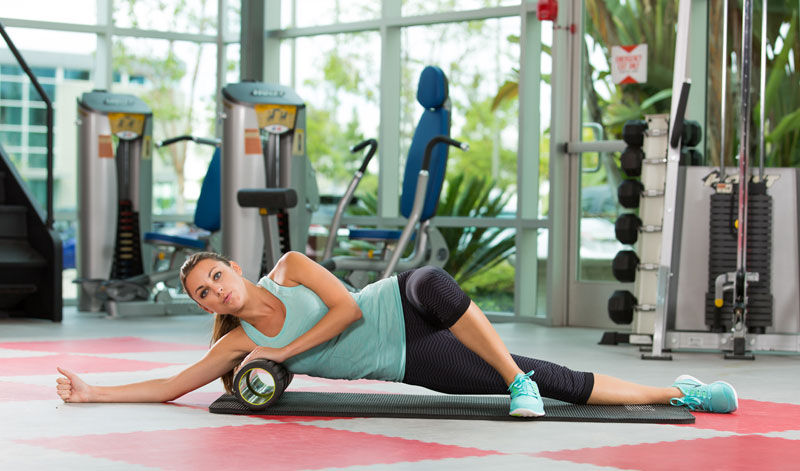
- Instruct the client to lie on his or her side with one arm outstretched on a foam roller placed just above armpit.
- Point the thumb up to lengthen the latissimus dorsi.
- Apply a mild amount of pressure with minimal movement over the length of the lattisimus dorsi
- If a knot or tender location is found, stop movement and rest on that location until pain subsides and release is achieved.
Trapezius/ Rhomboid/Posterior Deltoid
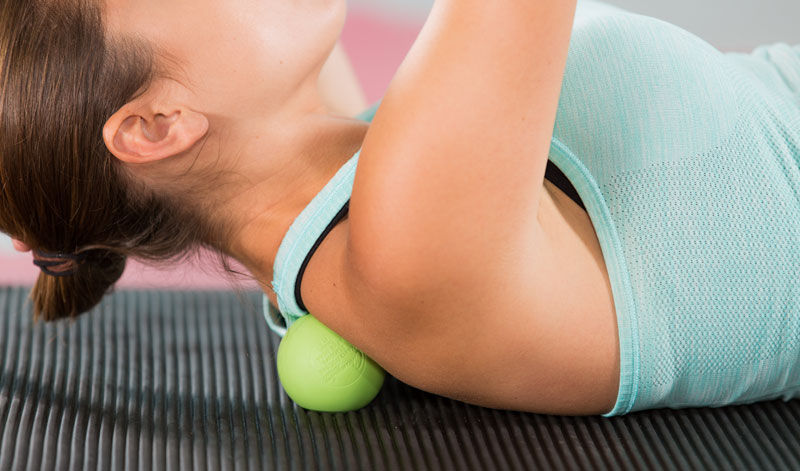
- Instruct the client to place a tennis ball between the wall and upper part of the trapezius.
- Instruct the client to slightly turn away from the wall.
- The client should roll back on the ball throughout the upper and mid trapezius, working it toward the posterior deltoid and then between the scapula and spine until knots or tender spots are found.
- Lift arm straight out and apply pressure on the tender location.
Lumbar Scoliosis
Lumbar scoliosis refers to a curvature in the lower (lumbar) portion of the spine. Individuals with lumbar scoliosis may be more likely to exhibit pelvic asymmetry, leg length discrepancies and low-back pain.
Erector Spinae/ Serratus Posterior/Multifidus
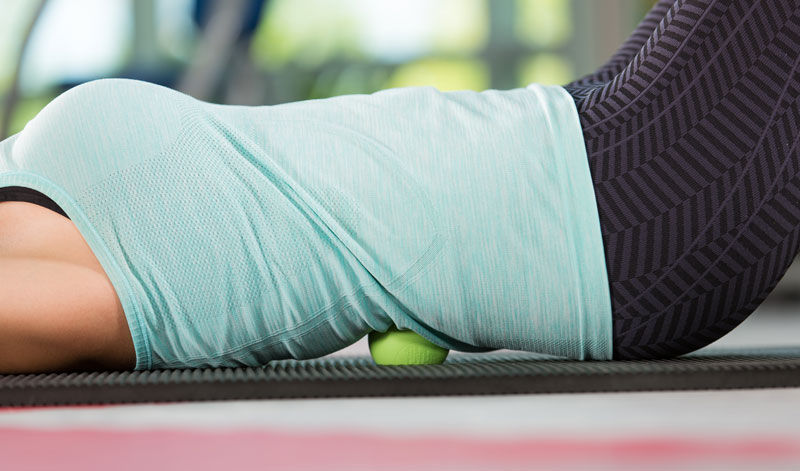
- Instruct the client to place a tennis ball between the wall and lower back on the concave side of the spinal curve
- Instruct the client to slightly turn away from the wall.
- The client should roll back on the ball in both vertical and diagonal patterns to address several layers of musculature from the L5-T11 portions of the spine.
- If a knot or tender location is found, stop movement and rest on that location until pain subsides and release is achieved.
Flexibility
Flexibility is the ability of a joint to move through its full range of motion. A well-designed flexibility regimen is important for restoring a normal length-tension relationship in the shortened skeletal muscle created by scoliosis. Improved flexibility can result in increased functional performance, improved postural symmetry and a decrease in both pain and potential for injury.
Arm Across Chest Stretch
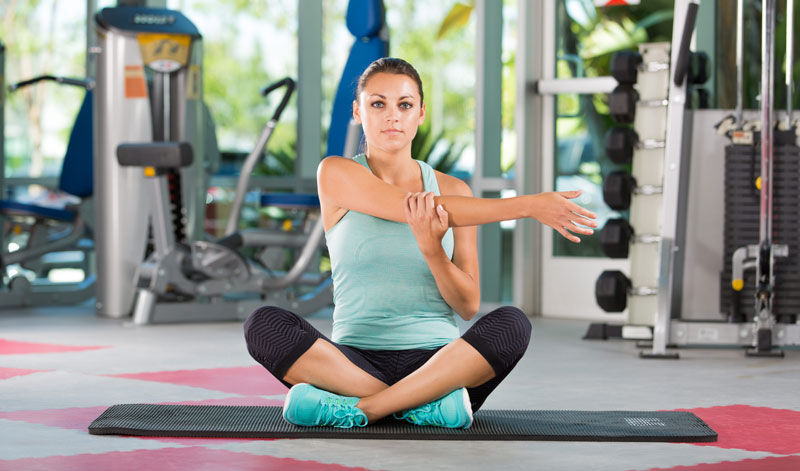
- Instruct the client to place one arm across the front of his or her body and grasp the elbow with the opposite hand.
- Have the client pull the arm across his or her body without twisting the torso.
Sitting Rotation Stretch

- Instruct the client to sit on the floor with both legs extended; cross one leg over the other.
- The client will slowly twist toward the bent leg, placing the hand behind the body for support.
- Have the client place the opposite arm on the side of the bent thigh to help increase the twist.
- Instruct the client to look over the shoulder and hold for the recommended time before slowly coming back to the starting position.
Cat/Cow Stretch

- Instruct the client to kneel on his or her hands and knees, with hips over the knees and shoulders over the wrists.
- Pull the navel toward the spine, rounding the back and feeling the stretch in the lower back. Hold for the recommended time.
- Lift the chest and tailbone, extending the spine and feeling the back arch. Hold for the recommended time.
Strength
Core Stabilization
Core stabilization exercises for scoliosis are fundamental to performance factors such as the transmission of power, balance, and posture. These factors are crucial to being able to successfully execute activities of daily living such as negotiating stairs, standing from a chair and picking up objects. Incorporating core stabilization into the program of an individual with scoliosis can dramatically improve postural symmetry and functional strength.
Bird-dog
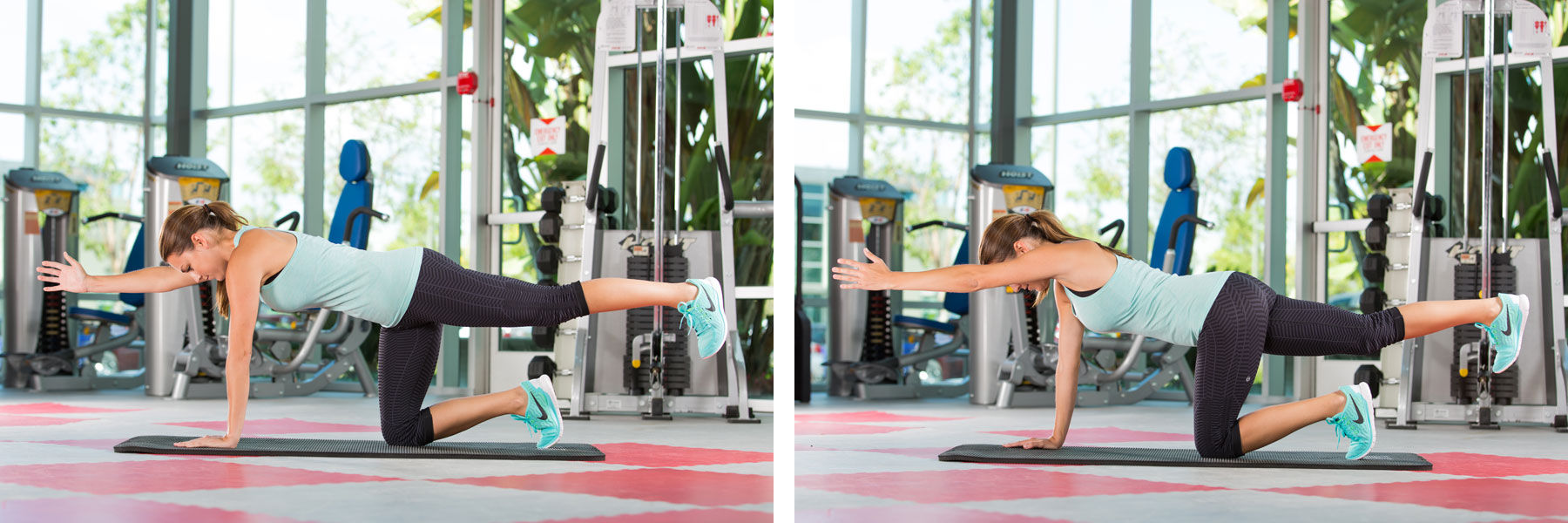
- Instruct the client to start on hands and knees, with shoulders positioned directly over hands and the hips over the knees.
- Raise one arm straight out in front to shoulder height, while maintaining a neutral spinal and hip position.
- Extend the opposing leg straight out from the hip.
- Hold this position for the recommended time, being sure to maintain a neutral hip and spinal position.
Hip Bridge
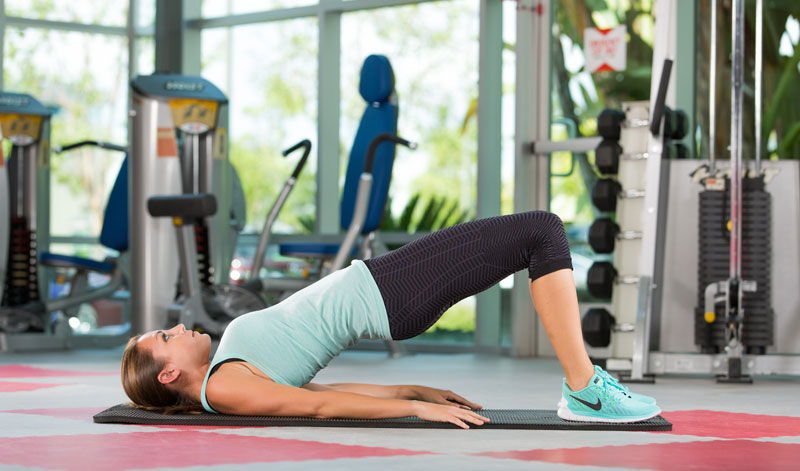
- Instruct the client to lie supine on the floor with arms at the sides, knees bent and feet flat on the ground.
- Contract the abdominal and gluteal muscles and lift the pelvis so that the body maintains a straight line from the shoulders to the knees.
- Hold this position for the recommended time.
Kneeling Cable Anti-rotation
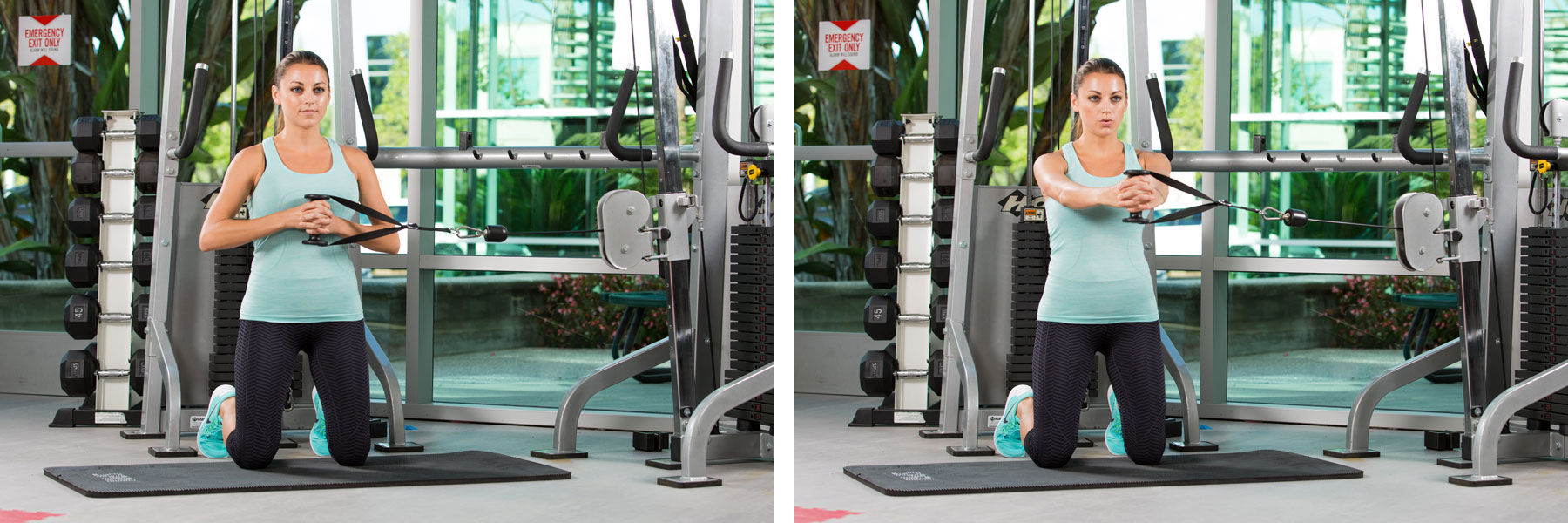
- Instruct the client to kneel perpendicular to a cable or band anchor and move a few feet away to allow for tension on the cable. The cable should be aligned with the client’s mid-section.
- Contract the abdominals and glutes, sit tall with the shoulders back and press the cable or band away from the body, staying in-line with the sternum until the elbows reach near lock out.
- Hold this position for a recommended amount of time while resisting rotation of the trunk and maintaining an upright position.
Unilateral Functional Strength Training
Because of the muscular imbalances that occur between the concave and convex side of the spine in individuals with idiopathic scoliosis, it is important that a strength-training regimen focus on unilateral exercises to strengthen the latent musculature of on the convex side of the spine without overdeveloping the shortened musculature on the concave side of the spine.
3-point Dumbbell Row
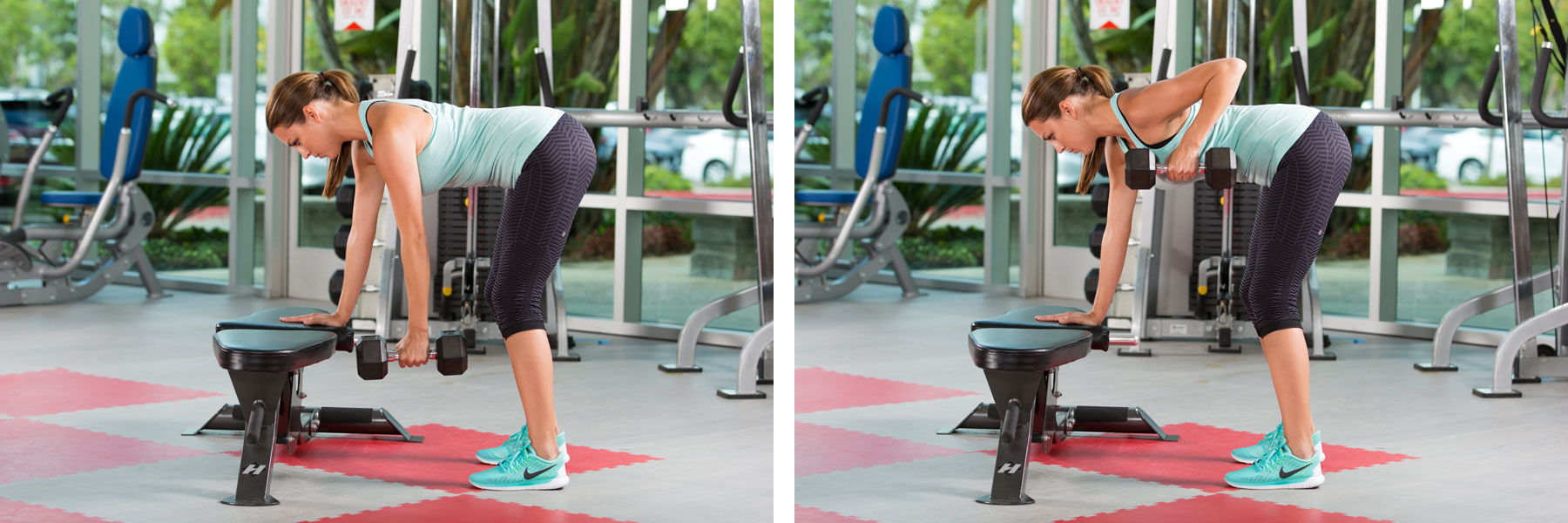
- Instruct the client to bend forward and place the left hand on a bench.
- The client’s feet should be directly under the hips, shoulder-width apart, and the back should be flat, with the head, spine and tailbone in alignment.
- With a dumbbell in the right hand, row the dumbbell up to the body by squeezing the shoulder blades back. Maintain a neutral spine.
- Lower the dumbbell and repeat for recommended repetitions with the right arm before repeating with the left arm.
Kneeling Cable Pulldown
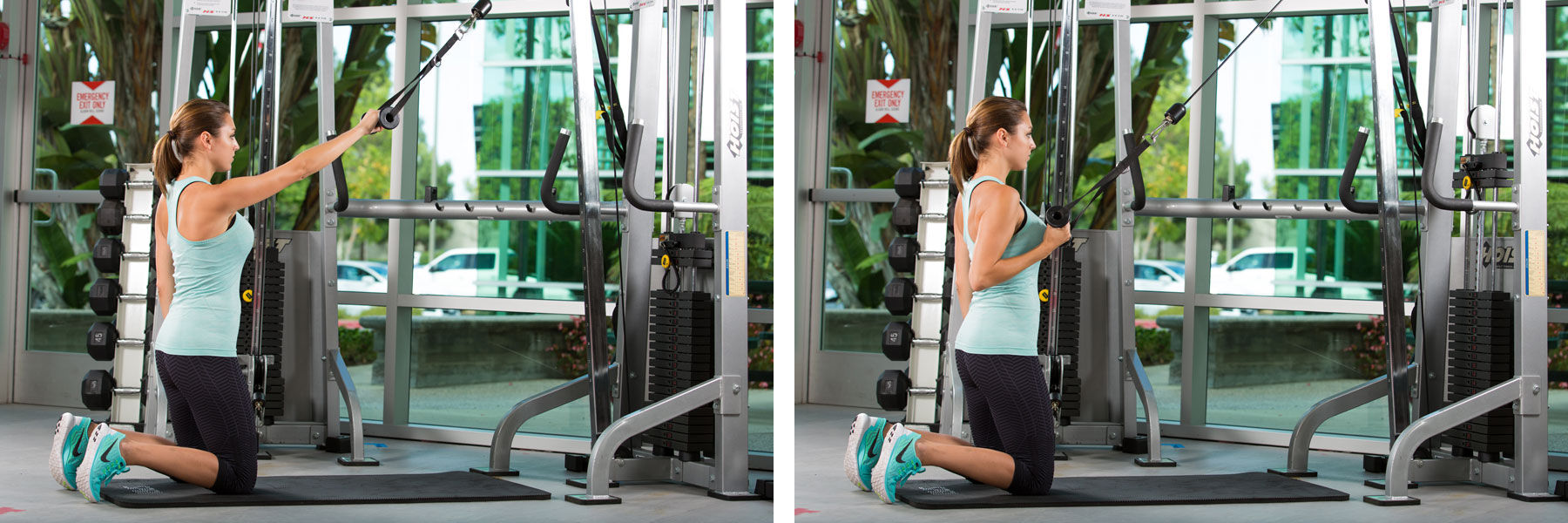
- Instruct the client to kneel in front of the cable tower( Are you facing the tower or away from the tower?), taking the cable with one hand with the arm fully extended.
- Starting with the palm pronated, pull the weight down to the torso by flexing the elbow and retracting the shoulder blade. The wrist will supinate so that at the completion of the movement, the palm is now facing the body.
- After a brief pause, return to the starting position.
Kettlebell Suit Case Deadlift

- Instruct the client to stand with feet hip-width apart and toes pointed forward. Place the kettlebell outside of one foot.
- Hinge at the hips, making sure the knees stay behind the toes.
- Load the latissimus dorsi and brace the abdominals.
- Keep a neutral spine and press through the floor and stand up.




 by
by 







 by
by